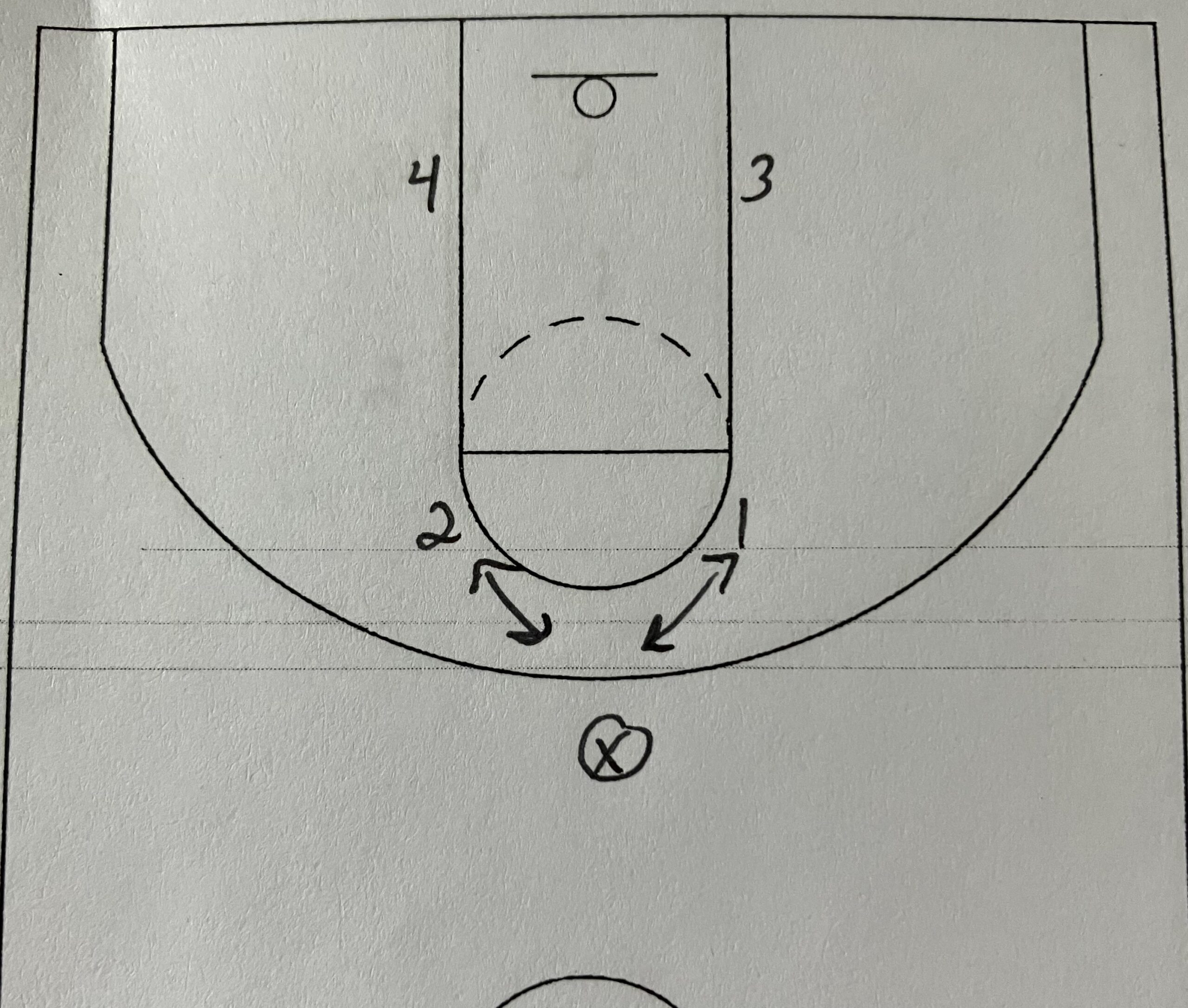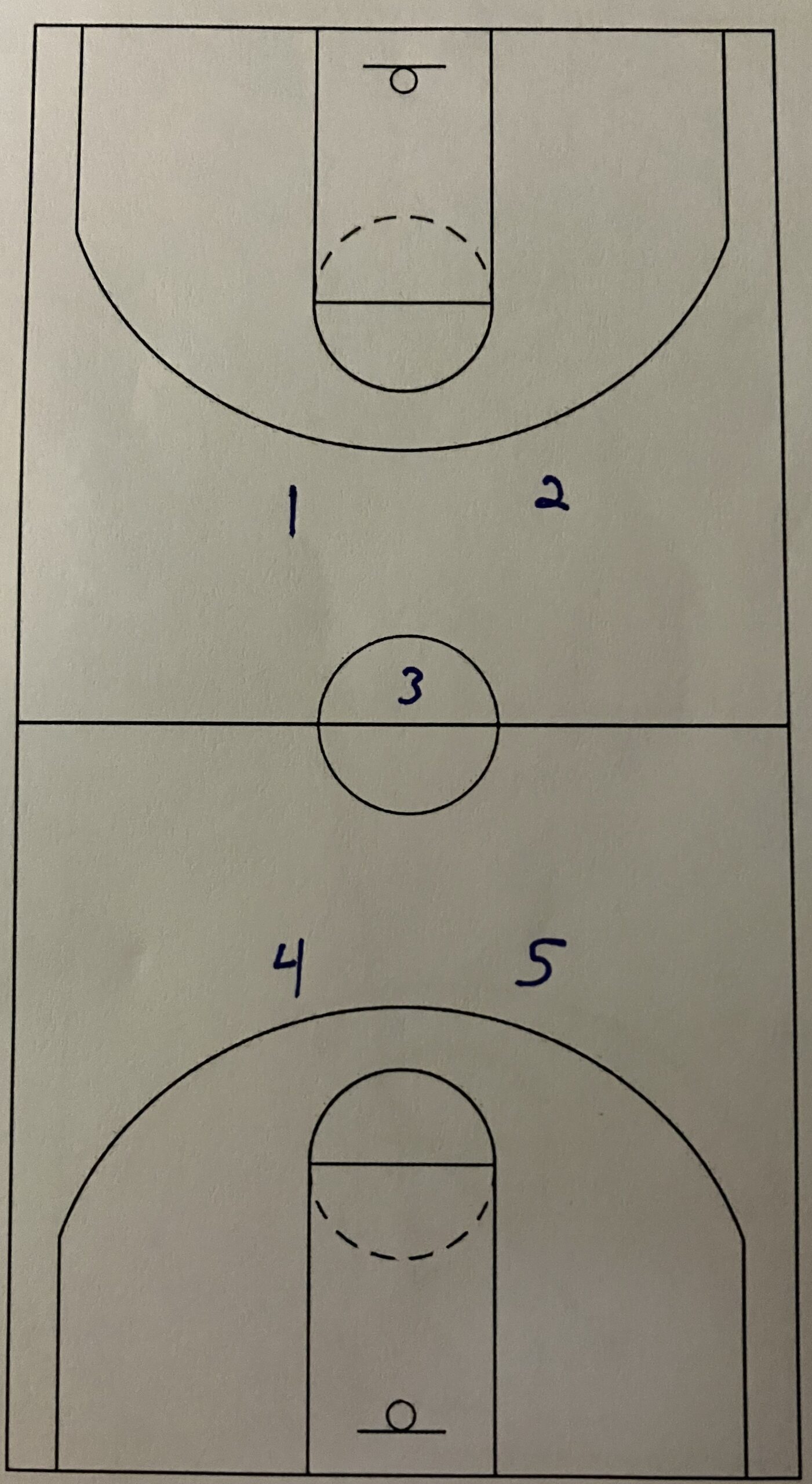1) Hard Hedge and Over the Top
A hard hedge is when the defender of the screener jumps out to try and push the ball away from the basket. The hedge should be tight to the screen. If there is space between the hedge and screener then the ball handler can slip through the gap and have a free run at the basket. The hedge should also have their shoulders in a line with the screener. This helps to push the ball handler away from the basket. If they are not turned basically sideways then the ball handler can extend his dribble and still be able to turn the corner around the hedge and attack the basket.
The screened defender needs to go over the screen. This means to go away from your defended basket to get around the screen. This is how I teach my players. I use this one teaching method to keep my defensive rules simple. To go over a screen, the lead foot of the defender needs to get above the high foot of the screener. The lead elbow can then be hooked around the high hip of the screener. If the elbow and foot are above the screener then the defender can pull himself over the screen. It is a simple concept but hard to get used too. Once a player learns how to go over then ball screens have trouble working.
The key to this entire setup is the 3rd man defending the pick and roll. The next defensive player must take a step or two towards the roll man in order to prevent the slip. If the 3rd defender is active in their movement then teams will have trouble scoring off a standard pick and roll.
2) Hard Hedge and Under
This is the same as the above but the screened defender will go under the screen. This means the on-ball defender will use a drop step to clear the screener and then work their way back up away from the basket to the ball handler.
I teach over the top instead of under because of two reasons.
A) if the ball handler is a shooter then they will have a moment when the screened defender is closing back out to them to shoot a wide open 3. I do not want to give the offense this space.
B) The screener can time the defender so when the defender is in between the screener and the basket then the screener can roll and turn the screen into a moving screen thus giving the ball handler more time and space to make a decision. By going over the top the screened defender cannot be affected in any other way.
The key difference between going over versus under is the space the defense gives the ball handler. If a team is a good 3 point shooting team then going under will give their players the time and space to shoot the ball. However, if a team is really good at driving to the basket then going over will give them one less defender in their way. Their are pros and cons to both going over and under. I suggest to pick one and teach that one concept so that your players get good at defending the pick and roll that way.
3) Soft Hedge and Over or Under
A soft hedge is when the defender of the screener plays back away from the screen. As the ball handler comes around the screen the hedge is playing off in what would be a normal defensive position. The problem is the defender is guarding the screener and not the ball handler. The screened defender can go either over or under. I would suggest if you are using the soft hedge then the on-ball defender go under the screen. If the defender goes over then it creates a big space for the ball handler to turn down off the screen and have a running start on the screener defender. If this is a big man hedging against a good ball handler then the ball handler should be able to make a move and get to the basket.
4) Double the Screen
If you want to be aggressive defensively then doubling the screen can be effective. This is where the on-ball defender goes over the top of the screen. The screener defender then either hard hedges or rushes the ball as the ball handler clears across the screen. Once both defenders are clear of the screen neither man leaves the ball until the ball handler passes the ball.
As a defense this can be a cat and mouse game. If there is a hard hedge then the ball handler should know the double is coming based upon the tendencies of the defense. This can lead to indecision on the ball handler’s part because they do not want to use the screen because they know the double is coming. If the defense rushes right after the ball screen then this can lead to the ball handler getting rushed and playing too fast. If a ball handler gets rushed then they could throw the ball away and that could lead to a turnover.
Again this type of defense is good for the teams who want to be aggressive in their defensive setups. However, there is the risk that the ball handler stays calm and uses a back dribble to bring the double team farther away from the basket. At a certain point the ball handler can then make a pass through the double team and give their team a 4 on 3 advantage which can lead to easy baskets for the offense. So this is the highest risk but also has the highest reward.
5) Switch the Screen
The next option is switching the screen. This should only be done by teams who have players that are all similar or who can guard every player on the other team. If you have a true center that is slow then you do not want to switch screens. This can lead your center having to guard possibly the point guard of the other team. This is a serious mismatch in most cases and not in the defenses favor. If a team is all about the same size then switching screens can work.
The only issue when switching screens is the initial on-ball defender must jump under the screener quickly on the switch to prevent a slip screen or a quick roll from the screener. Switching the screen is probably the easiest to learn, teach and do in a game. This gives the offense the ability to dictate which defender guards which offensive player.
6) Jump the ball Screen
The last way to defend the ball screen is to jump the ball screen. I see this done mostly in the NBA. The on-ball defender sees the screen coming and jumps to the high hip of the screener and forces the ball handler to go away from the screen. As the on-ball defender jumps the screen this opens a straight lane drive to the basket. The screener defender must come up and guard the ball normally until the ball handler makes a decision as to what to do.
If the ball handler still tries to use the screen then they dribble straight into their defender. If they dribble towards the basket then the on-ball defender follows and creates a natural trap with the screener defender staying in front of the ball handler. I have not seen many high school teams run this type of defense. This could be used and possibly create a bunch of confusion for an opposing team due to lack of familiarity with it.



13 thoughts on “Defending the Pick and Roll”